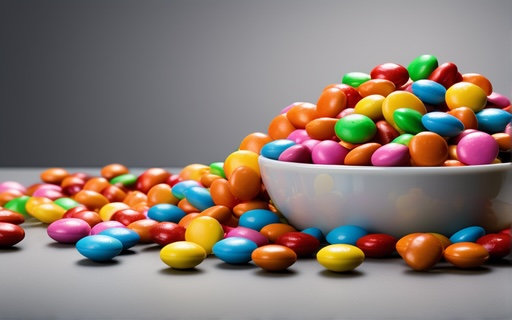Internet Asks: "Calories in M&M's"
M&M's, the colorful button-shaped chocolates that have been a favorite treat for generations, are not just known for their vibrant hues and catchy slogan "Melts in your mouth, not in your hands." These delightful candies also come with a caloric content that consumers often wonder about. This article dives into the caloric content of various types of M&M's, offering insights for those looking to enjoy this classic treat while being mindful of their dietary intake.
sponsored links

Caloric Content of M&M's
The calorie count in M&M's can vary depending on the type. From the classic milk chocolate to peanut, and even to the more gourmet variations, here’s a breakdown:
-
1. Milk Chocolate M&M's:
- - Serving Size: 1.69 ounces (about 47.9 grams or roughly 1/4 cup)
- - Calories: Approximately 230 calories per serving
- The original milk chocolate M&M's set the standard with a simple yet irresistible combination of milk chocolate encased in a sugar shell.
-
2. Peanut M&M's:
- - Serving Size: 1.74 ounces (about 49.3 grams or roughly 1/4 cup)
- - Calories: Approximately 250 calories per serving
- Peanut M&M's, with their crunchy center, offer a bit more in terms of calories, largely due to the added peanuts which contribute additional fats and proteins.
-
3. Peanut Butter M&M's:
- - Serving Size: 1.63 ounces (about 46.2 grams or roughly 1/4 cup)
- - Calories: Approximately 240 calories per serving
- These combine the creamy texture of peanut butter with chocolate, offering a slightly higher calorie count due to the peanut butter filling.
It's worth noting that these values can differ slightly based on packaging and regional formulations. Always check the packaging for the most accurate and current nutritional information.
Nutritional Breakdown
In addition to their caloric content, it's essential to understand the broader nutritional profile of a serving of classic M&M's:
- - Total Fat: 10 grams, with 6 grams being saturated fat. The fat content primarily comes from the chocolate and the candy coating.
- - Cholesterol: Less than 5 mg, as chocolate contains minimal amounts of cholesterol.
- - Sodium: 30 mg, a relatively low amount, given that M&M's are primarily a sweet rather than savory snack.
- - Total Carbohydrates: 34 grams, with 30 grams coming from sugars. The carbohydrates in M&M's are predominantly from the sugar in the candy coating and the chocolate itself.
- - Protein: 2 grams, which is minimal, as M&M's are not a significant source of protein.
Ingredients Contributing to Calories
The caloric content in M&M's can be attributed to the following key ingredients:
- - Milk Chocolate: The core of M&M's, milk chocolate provides both the creamy texture and a significant portion of the calories.
- - Sugar: Both the chocolate and the candy coating contain sugar, contributing to the total caloric and carbohydrate content.
- - Cocoa Butter: Used in making chocolate, cocoa butter adds to the total fat content.
- - Peanuts/Peanut Butter (for specific varieties): Increases the protein content but also adds to the calorie and fat content.
- - Dextrin: A type of carbohydrate used in the candy shell, adding to the total carb count.
- - Artificial Colors: While these don't contribute to the caloric content, they are responsible for the vibrant colors of M&M's.
sponsored links
Moderation is Key
While M&M's are a tasty treat, their high sugar and fat content make them a calorie-dense snack. Enjoying them in moderation is crucial, especially for those keeping an eye on their caloric intake or managing health conditions like diabetes.
Creative Ways to Enjoy M&M's
Incorporating M&M's into your diet doesn't have to mean forsaking your health goals. Here are a few tips to enjoy them mindfully:
- - Portion Control: Opt for fun-size packs or pre-measure servings to avoid overindulgence.
- - Balanced Snacking: Pair a small serving of M&M's with a handful of nuts or some fruit to balance the nutritional profile of your snack.
- - Special Occasions: Save M&M's for special treats or occasions rather than daily consumption to maintain a balanced diet.
Conclusion
M&M's, with their irresistible taste and colorful appeal, are a delightful treat that, when consumed in moderation, can fit into a balanced lifestyle. Being mindful of their caloric and sugar content allows you to enjoy these classic candies without compromising your nutritional goals. So, the next time you reach for a pack of M&M's, savor each piece, knowing exactly what it entails.
Disclaimer: This article is for informational purposes only and is not intended as health or dietary advice. Always consult a healthcare professional or a registered dietitian for personalized dietary guidance.
sponsored links
References
- 1. MMS.COM. Ingredients Nutrition Information. https://www.mms.com/en-ie/nutrition-information
- 2. USDA FoodData Central. Candies, MARS SNACKFOOD US, M&M's Peanut Chocolate Candies. https://fdc.nal.usda.gov/fdc-app.html#/food-details/169582/nutrients
- 3. USDA FoodData Central. Candies, MARS SNACKFOOD US, M&M's Milk Chocolate Candies. https://fdc.nal.usda.gov/fdc-app.html#/food-details/169583/nutrients
- 4. USDA FoodData Central. Candies, MARS SNACKFOOD US, M&M's Peanut Butter Chocolate Candies. https://fdc.nal.usda.gov/fdc-app.html#/food-details/167689/nutrients
- 5. Harvard Health Publishing. The sweet danger of sugar. https://www.health.harvard.edu/heart-health/the-sweet-danger-of-sugar
- 6. EWG's Food Scores. M&m's Chocolate Candies, Peanut Butter. https://www.ewg.org/foodscores/products/040000513018-MmsChocolateCandiesPeanutButter
People are also reading...
Calories in Brown Sugar
Calories in Mayo
Does Kimchi Cause Cancer?
Kimchi Calories
Kimchi Cancer
Losertown Calc
Where is Kimchi in Grocery Store?
Mifflin St Jeor Calculator
Where to Find Kimchi in Grocery Store
Ready to level-up?
Create meal plans 10x faster, follow up with your clients through our mobile app, and never struggle with meal planning or recipe management again.